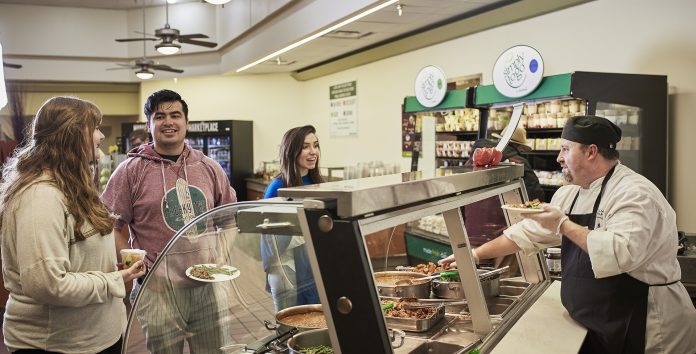CW: Eating disorders
Normal dining halls terrify me. The freedom of choice is overwhelming. Once, during my freshman year, I wandered through the labyrinth of The Caf for 15 minutes before walking out without any food.
Marketplace used to be a haven from my disordered thoughts.
Its á la carte dining did the work of portioning and selection for me — I always got an entree, a side, a dessert, and a drink. I didn’t have to think about it. I didn’t feel guilty about eating too much food. I left feeling encouraged and strong.
But now, because of Marketplace’s changes, if I take enough food to satisfy my hunger and follow the meal plan prescribed by my dietician, I’m forced to pay extra or haggle with the cashier.
“I’ll let you take that cookie today, but next time, it’ll be extra.”
And all at once I’m a failure, too weak and dumb to follow the rules — if the powers that be set the price of a meal swipe at eight dollars, then surely any combination over that amount is gluttonous.
The thoughts swirl.
I throw the cookie in the compost bin.
I eat a Caprese sandwich with no chicken.
I go to bed hungry.
The new Marketplace setup has quickly come under campus scrutiny. Its eight-dollar meal swipe limit leads to longer lines and more expensive food. These are valid frustrations, but in the thick of anorexia recovery, my issues with the dining hall cut deeper.
My most scarring experience involved a salad. (Yes, it’s funny. Eating disorders are awful, and they’re also hilarious. I cried over a jelly donut a few days ago. You can laugh about it with me. I give you permission).
First, some background — I’m in a phase of recovery called re-feeding. It basically means that I have to eat a lot of food to make up for years of starvation. During that process, I have to choose calorie and nutrient dense foods. Otherwise, I’ll feel full before I’ve gotten the energy that my body needs to recover.
Iceberg lettuce and shredded carrots won’t work for me. I need avocado, hummus, tomatoes and tortilla chips. Those foods tend to be heavier in terms of mass, which doesn’t jive well with the new policy at Marketplace.
Gone are the days when a large salad cost the same no matter what you piled into your plastic to-go container. Salads are priced by the ounce.
It took me years to internalize the reality that my weight doesn’t define my worth. Apparently, that privilege doesn’t extend to Marketplace meals.
My first week back on campus, I plopped a salad on the scale that clocked in at a whopping thirteen dollars. The cashier’s eyes widened.
“You’ve got to watch it with the salads,” they said. “I won’t charge you this time, but you’ve got to watch it. It’s too heavy.”
Too heavy. My food was too heavy.
A dread settled over me akin to the nausea I used to feel every time that I stepped on a bathroom scale. Who did I think I was? Why couldn’t I serve myself food that weighed a normal amount? How could I consume this now, knowing the extent of its excess?
I ate the salad, slowly and painfully, because I want to get better, but it shouldn’t have been such a battle. I shouldn’t be subjected to a dining hall setup so antithetical to my recovery plan.
Marketplace employees aren’t the problem; the new policy is. Marketplace should return to its original system or transition to an all-you-can-eat dining location. If nothing changes, students will continue paying too much money for not enough food. More disturbingly, W&M Dining will continue supporting a system that compels food restriction and shames food choices.
This author is a student at the College of William and Mary and has chosen to remain anonymous. If you would like to respond, email fhopinions@gmail.com.

